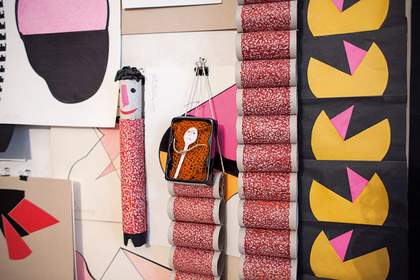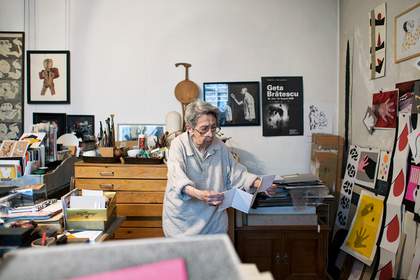
Geta Brătescu in her Bucharest studio, February 2015, photographed by Stefan Sava
My first work was with white paper, torn and arranged on the floor against the wall. I was about five years old.
Geta Brătescu is in her studio, adjacent to her house in a leafy suburb of Bucharest where she has lived since the early 1970s. It is fitting that her earliest recollection of making art relates to collage, as the main wall and many surfaces in the room are covered in patterns made of brightly coloured paper, what she calls ‘drawing with scissors’. The artist is about to enter her 90th year and still comes to the studio every day, mostly working on a continuing series of collages called Jeu des Formes, in which a play of coloured shapes bounce around, giving the space a great sense of movement. ‘There is a dance between drawing and collage,’ she notes, ‘a kind of game.’

Geta Brătescu in her Bucharest studio, February 2015, photographed by Stefan Sava
Born in 1926, Brătescu originally trained at the Academy of Fine Art in Bucharest, where she studied drawing from 1945 to 1948. ‘I was successful, and worked hard for nearly three years, but was then expelled before finishing.’ This was due to the rise of the communist party, and a subsequent review of students’ backgrounds. Those whose families had property, as in the case of Brătescu whose parents had eventually bought the pharmacy they had both worked in for years, were considered to be from ‘bad origins’.‘It was not very good, you know, but I still loved drawing and I continued to draw… I lived in Bucharest with my aunt, my mother’s sister, and I started drawing for different institutions, illustrating children’s books.’
It was perhaps unsurprising that she was attracted to illustration, as she had also taken a course in literature alongside her studies in fine art: ‘I always loved to write, and I still do.’ She attributes this to her mother, who was a keen reader and amassed a collection of French literature in an elaborate wooden cabinet that Brătescu still keeps in her studio. It becomes clear that every piece of furniture here has a story, often one that in some way relates to her work. The two original Thonet chairs that we sit on belonged to her mother-in-law, and featured in performance works in the 1990s. A large dark wood shelved cupboard holds her published material – writings, poems and illustrations – and was her mother’s. And the beautiful old brass lamp made electric which spreads light from the centre of the room was salvaged by her late husband.

Geta Brătescu in her Bucharest studio, February 2015, photographed by Stefan Sava
During the early years of Nicolae Ceaușescu’s administration in the late 1960s there was a cultural thaw in relations with the West and a more moderate communism. It allowed Bratescu to complete her studies and she returned to university in 1969, which crucially offered studio space, prompting a series called simply The Studio:
It was magnificent! I worked every day in my studio. It was amazing for me. It was a space without politics, it was my self.
The works in this series, made throughout the 1970s, show Brătescu’s experience of the studio through drawings and filmed performances. In perhaps her most famous film, 1978’s The Studio, made with Ion Grigorescu in a new studio at the Artists Union, she measures her size in the space, marking her individual and unique place in the world. Questions of selfhood remained important to her work during the 1980s and 1990s, and she is unequivocal when asked how much of her art she considers to be self-portraiture: ‘Everything! Even when I made the book illustrations, it was always me.’

Geta Brătescu in her Bucharest studio, February 2015, photographed by Stefan Sava
She moved her studio to her house in the 1990s, and it remains a mirror of her work and her identity, as remnants from performances and photo-collages sit alongside curios collected on her travels. She recalls finding a pair of tiny wooden acrobats on the street in Venice during the 1960s, one ‘dancing’ some metres away from the other. Thinking them charming, they made their way into the studio, suspended in a perpetual miniature performance. The main wall covered in collages, puppets and drawings in felt-tip pen, many created during the past five years, makes it clear that Brătescu has no intention of slowing down, and she is animated as she discusses the vibrancy of these works, in themselves forming an enormous collage. ‘Some people sing to themselves all the time,’ she shrugs, ‘I sing with my pens.’
